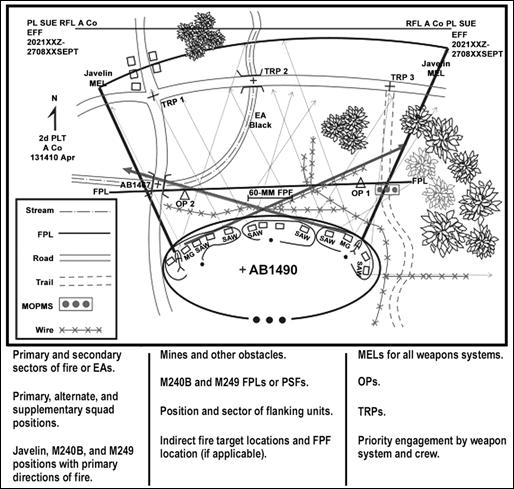Антипову:
Если Вы хотите свести вопрос к дотам, могли бы сразу отослать к соответствующей главе бувса - прорыв укрепленного района, там ни сказано ни про танки впереди пехоты, ни про безостановочное движение цепью за танками. Речь же идет о другом, о том, что в филдмануалах называется Final Protective Line и interlocking fire.
вот тут нарисована Final Protective Line -- заграждения + заградительный огонь 60мм минометов + два пересекающихся направления огня пулеметов

http://www.globalsecurity.org/military/ … index.html
https://www.google.ru/search?tbm=bks&am … &btnG=
final protective fire (FPF) (JP 1-02, NATO) - An immediately available prearranged barrier of fire designed to impede enemy movement across defensive lines or areas. (See also battle position (BP), defend, and final protective line (FPL).) See FMs 7-7, 7-8, 7-10, 7-20, 7-30, and 71-123.
FM 3-21.71
приложение G
FIRE CONTROL AND DISTRIBUTION TECHNIQUES
Final Protective Line.
The FPL is a line of fire established where an enemy assault is to be checked by the interlocking fires of all available weapons.
The unit reinforces this line with protective obstacles and an FPF whenever possible.
Initiation of the FPF is the signal for elements, crews, and individual soldiers to shift fires to their assigned portion of the FPL.
Вольный перевод:
Final Protective Line - рубеж, с которого вражеская атака подподает под перекрестный огонь всего имеющегося оружия.
Этот рубеж усиливаетя заграждениями и зонами заградительного огня (FPF - Final Protective Fire).
Начало заградительного огня - сигнал к открытию огня подразделением по назначенным участкам FPL
Cross Fire.
Leaders initiate cross fire when targets are arrayed laterally across the unit's front in a manner that permits diagonal fires at the enemy's flank or when obstructions prevent unit weapons from firing frontally.
Right flank weapons engage the left-most targets; left flank weapons engage the right-most targets.
Firing diagonally across an engagement area provides more flank shots, thus increasing the chance of kills.
It also reduces the possibility that friendly elements will be detected if the enemy continues to move forward. As they destroy enemy targets, weapons shift fires toward the center of the enemy formation.
глава 5
5-9. ENEMY ASSAULT
(3) The enemy closes on the platoon's protective wire.
Machine guns and squad automatic weapons fire along interlocking principle directions of fire or final protective lines as previously planned and designated. These may include BFV weapon systems or the platoon's M240Bs. Other weapons fire at their designated principle direction of fire (PDF). Grenadiers engage the enemy with M203 grenade launchers in dead space or as the enemy attempts to breach protective wire.
The platoon leader requests final protective fires if they have been assigned in support of his positions.
Section VIII. FIGHTING AND SURVIVABILITY POSITIONS
....
Leaders must ensure fighting positions provide mutually supporting, interlocking fires. This allows them to cover the platoon's sector from multiple positions.
When possible, site positions behind natural cover, and in easily camouflaged locations. The enemy must not be able to identify the position until it is too late and he has been effectively engaged.
или вот:
http://www.military-sf.com/Tactics.htm
The Defense
In the defense, fireteam members are deployed in pairs, two to a fighting hole. The machine gunner is carefully placed so that any approaching enemy are more likely to encounter him. Because the machine gunner is the second senior man in the fireteam, the team leader mans a different fighting position. This way, if the team leader is killed, the machine gunner can take command and pass his weapon to the person with him. They are separated so one explosion doesn't kill them both.
The machine gun is of critical importance in the defense. Usually it is deployed along the flattest piece of ground so that it can fire farther along that line effectively. This is called grazing fire. The machine gun bullets graze the ground from one foot up to four feet. Any attackers crossing the machine gun's path is vulnerable to this grazing fire, even if smoke or weather obscure the machine gunner's view.
A stake is also used to designate the machine guns FPL, or final protective line. When the enemy is about to over run the unit, the FPF (Final Protective Fire) command will be given. This means the machine guns especially will create a wall of bullets across the units front. Anyone crossing this line will be in severe danger from the machine gun firing as fast as it can. When two or more machine guns use interlocking fields of fire it creates a near impenetrable wall of fire. This makes it doubly important that machine guns be manned.
When barbed wire is used, a roll can be deployed along the machine gun's path. This way any enemy soldiers who run into the barbed wire will be stopped temporarily in the path of the machine gun. Another strand will discourage enemy troops from getting within hand grenade range of the machine gun position.
The grenadier is placed so he can fire into places the machine gun cannot.

от сюда
http://www.globalsecurity.org/military/ … esson1.htm

от сюда
http://www.globalsecurity.org/military/ … 79/ch1.htm
 . Поскольку на циферблате 22:50, и я только пришел с работы домой, не имею пока возможности полноценно ответить. А к неполноценным набросам не привык. Как получиться освободиться хотя бы часа на 3-4, так отвечу.
. Поскольку на циферблате 22:50, и я только пришел с работы домой, не имею пока возможности полноценно ответить. А к неполноценным набросам не привык. Как получиться освободиться хотя бы часа на 3-4, так отвечу.




